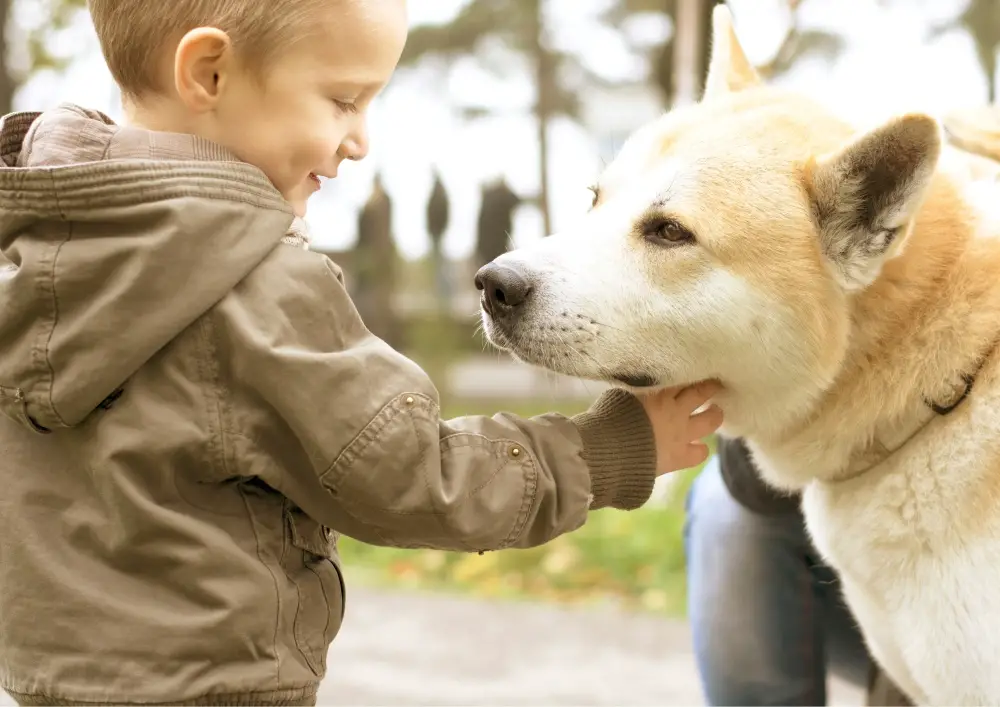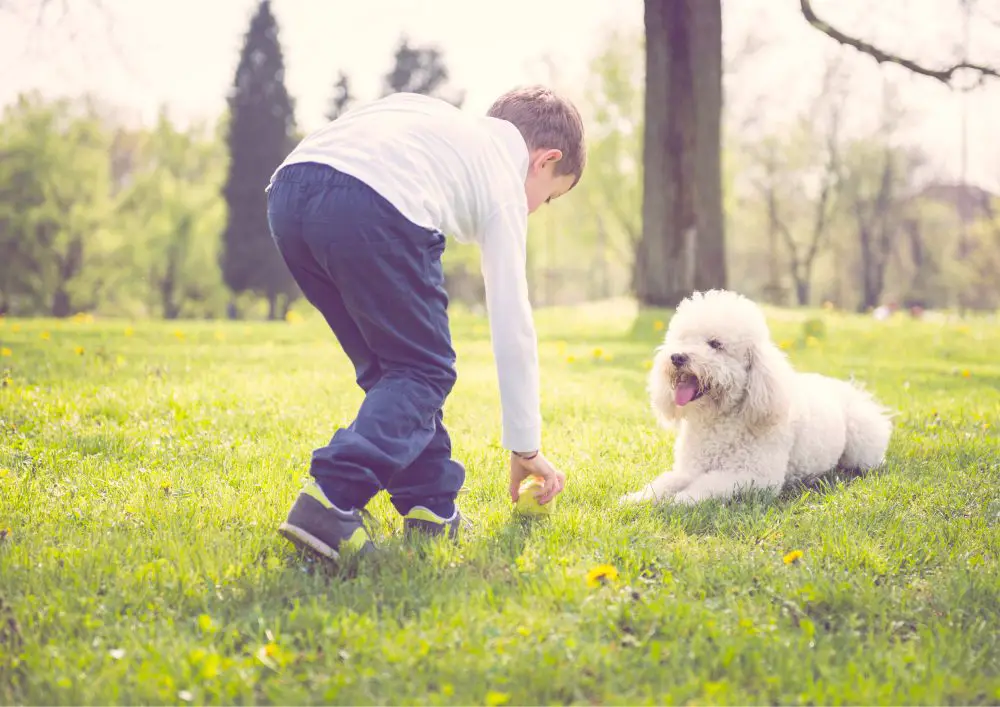Bringing in a new dog to your family takes plenty of work, including the time and effort to teach your children. Kids need to understand how to play with a new four-legged family member in the house. Doing so lowers the risk of bites while encouraging your kids to bond with the new family dog.
Below is a guide on showing your kids how to treat dogs in your house.
Contents
Read Your Dog’s Body Language for Dog Safety
How your dog moves can tell you what they feel or are about to do. Your kids will know the best approach to the family pet if they understand their tail wagging and ear positions. Here are the common body language to look out for:
Understanding Tail Wags
You might think a wagging tail always means a happy dog. That’s only sometimes true. The way a dog wags its tail can mean different things. A high and wagging tail usually shows the dog is happy and comfortable. But a low wagging tail might mean the dog is insecure or submissive.
Watch out for a stiff tail that points straight up or out. This tale position could be a sign that the dog feels threatened or aggressive. Teach your kids to notice the direction and height of the tail wag. This simple observation can tell a lot about how the dog is feeling.
Ears and What They Mean
Ears are another big clue. When a dog’s ears are perked up, it’s usually alert or interested in something. But the dog might be scared or submissive when the ears go back.
Folded-back ears can also mean the dog is not feeling well or is in pain. Let your kids know that when a dog’s ears change position, it’s communicating something. They should pay attention and adjust how they interact with the dog accordingly.
The Importance of Eye Contact

Eye contact with a dog can be tricky. In the human world, making eye contact shows confidence. For dogs, it’s a bit different. Direct eye contact could be seen as a challenge or threat by the dog.
Tell your kids not to stare into a dog’s eyes, especially a dog they don’t know well. Conversely, if a dog avoids eye contact and looks away, it’s usually a sign of submission or discomfort. Understanding this can prevent unwanted tension between the child and the dog.
Reading a Dog’s Mouth and Teeth
A dog’s mouth can tell you a lot, too. An open mouth with relaxed lips usually means the dog is comfortable. A closed mouth could mean the dog is focused or getting tense.
If a dog shows its teeth and growls, take it seriously. This is a clear sign the dog feels threatened or defensive. Ensure your kids know this means to back off and give the dog space immediately.
Decoding the Dog’s Posture
How a dog stands or sits can be telling. A relaxed, standing pose usually indicates a comfortable dog. If the dog crouches or lowers its body, it might feel submissive or scared.
Conversely, a dog that raises its hackles or stands on its toes is likely feeling threatened or aggressive. Teach your kids to be aware of these postures. They should know when it’s safe to approach the dog and when to give it space.
Understanding your dog’s feelings and actions can help your children know if they are treating them properly.
Approaching a Dog Safely
Knowing how to approach a dog safely is key to a positive interaction. Kids often get excited and might rush towards a new dog, which can overwhelm the pet. Teaching your children the right steps ensures everyone’s safety and comfort.
Slow and Steady Approach
Kids often get excited and want to run straight to a new dog. But sudden movements can make the dog anxious or scared. Teach your kids to approach the dog slowly and steadily. No running, jumping, or fast movements. This helps the dog understand that they’re not a threat.
Have your kids walk towards the dog with their side or back facing it, rather than approaching head-on. Facing a dog can be seen as an aggressive child who looks less threatening to the dog by approaching sideways or at an angle. Make sure your kids know to keep a close watch on the dog’s body language as they approach. If the dog shows discomfort, it’s time to back off.

Hand Signals and Initial Contact
When kids get close to the dog, they should let the dog come to them first. Teach them to extend their hand slowly for the dog to sniff. But keep their fingers closed, forming a fist. An open hand might look like a treat to the dog, and we want to avoid any accidental nips.
Explain to your kids that sniffing is a dog’s way of getting to know them. It’s like a handshake for humans. Once the dog has sniffed and seems comfortable, that’s usually a good sign that it’s okay to pet the dog. But remember, always stay alert to the dog’s body language.
Staying Calm and Quiet
Loud noises and sudden moves can spook a dog. Stress the importance of staying calm and quiet during the interaction. Teach your kids not to yell, shout, or make loud noises. Soft, gentle talk can be comforting to a dog.
Explain that dogs have sensitive ears. Loud sounds can make them uncomfortable or scared. Even if the dog does something cute or funny, remind your kids to react calmly and quietly. Their behavior keeps the dog at ease and helps your kids develop good animal interaction habits.
The Right Spots to Pet
It’s important to know where to pet a dog—dogs generally like being touched on their back, shoulders, or chest. Teach your kids to avoid sensitive areas like the face, paws, and tail. Some dogs might also not like their belly touched, especially at first.
The first touch should be gentle and brief. Start with one or two soft pets and then pause to see how the dog reacts. If the dog seems happy and relaxed, it’s usually okay to continue petting. Remind your kids always to watch the dog’s body language. If it shows discomfort, it’s time to stop petting and give the dog space.
Teaching your kids how to approach a dog safely sets them up for positive experiences. Once these habits are in place, it becomes second nature, creating a safe environment for everyone.

Safe Play and Interaction
Playing with a new dog is fun but needs to be safe for both the dog and your kids. It’s not just about throwing a ball or a toy; it’s about understanding the dog’s comfort zone. Proper play keeps everyone happy and avoids accidents or misunderstandings.
Choose the Right Toys
Picking the right toys for playtime is more than grabbing something off the store shelf. Some toys could be dangerous for dogs. For example, small toys might be a choking hazard. Always choose toys that are the right size and safe for your dog’s breed and age.
Squeaky toys and balls are generally good choices for many dogs. But every dog is different. Some might prefer plush toys, while others like something they can chew. Teach your kids to observe what toys the dog enjoys. Once they understand the dog’s preferences, they’ll know which toys to pick for a fun and safe playtime.

Setting Play Boundaries
It’s crucial to set boundaries during play. Your kids should know where it’s okay to play and where it’s not. For instance, playing near stairs can be dangerous. Designate a safe play area where the dog can run around without risks.
Teach your kids to control the game. For example, they should hold the toy above the dog’s head and ask for a “sit” before throwing it. This keeps the dog focused and teaches them to follow commands. It’s all about making playtime safe but still fun.
When to Take a Break
Playtime can get exciting, but breaks are necessary. If a dog starts panting heavily or seems worn out, it’s time to stop. Overexertion isn’t good for dogs, especially in hot weather. Teach your kids to give the dog water and a quiet resting place.
Breaks also help when the play gets too rowdy. If the dog starts jumping or nipping, it might be overstimulated. A short break can calm everyone down. Remind your kids that playtime should be enjoyable for the dog too. They should look for signs that the dog needs a break.
Reading Playtime Signals
Understanding a dog’s body language during play is important. If the dog wags its tail and has a relaxed body, it’s probably enjoying the game. But a stiff posture or growling means something’s wrong. Teach your kids to stop playing if they notice these signals.
Explain that a dog might not always want to play. Sometimes they may want just to chill or go for a walk. Your kids should understand that and respect the dog’s choice. They need to learn that the family pet deserves their respect, and doing so will keep them safe. This lesson can be highly valuable for your children as they grow up.
Supervised Play is Safe Play
Never leave kids and dogs alone during playtime, especially if they’re still getting to know each other. Adult supervision is necessary to keep your kids and your dog safe while they play. You can step in as an adult if the dog or the kids are not following the safety rules. You can also ensure the dog doesn’t accidentally hurt the child in its excitement. Having mom, dad, aunt, or uncle around will prevent anyone from getting too rowdy.
Safe play is joyful play. Everyone has a good time when your kids understand how to interact safely with their new furry friend. Children can learn about being respectful of others’ space and their behavior. They will carry these lessons when meeting other kids outside their homes.
When to Leave a Dog Alone

Dogs, like humans, have times when they want to be alone. Understanding when to give a dog space is crucial for a harmonious home. Just like people, dogs have moods and feelings. Sometimes, they may be tired, anxious, or even unwell. Teach your kids to recognize the signs that indicate it’s time to leave the dog alone.
One clear sign is if the dog retreats to a specific area, like its bed or crate. This place is the dog’s safe space. Teach your kids that when the dog is in its safe space, it’s off-limits—no petting, no calling, and no pulling the dog out to play. The dog needs time to relax and recharge.
Another signal is body language. If the dog’s ears are back, its tail is low, or it’s avoiding eye contact, those are signs to back off. Some dogs may also growl or show their teeth if they want to be left alone. These are warning signs that should be taken seriously. If your kids hear or see any of these, they should move away immediately.
It’s not just about the dog’s body language, though. Consider other situations when a dog should be left alone. For example, while it’s eating or drinking. Dogs can be protective of their food. Teach your kids not to disturb the dog during mealtime or when it’s enjoying a treat.
Another scenario is when the dog is asleep. Dogs, especially puppies, sleep a lot. Interrupting their sleep can make them grumpy or disoriented. Let sleeping dogs lie, as the saying goes. Teach your kids to let the dog wake up naturally before interacting.
It’s also crucial to consider the dog’s health. If a dog is unwell, it will likely want to be alone. If your dog is sick, make sure to keep the kids away. A sick dog may be more irritable and less tolerant of noise and movement.
Handling Unfamiliar Dogs
Meeting a strange new dog can be unnerving for kids if they do not know what to do. This situation happens when you bring home a new pet. It can also happen when your family visits a friend or relative who owns a dog. Below are steps in teaching your kids how to deal with unfamiliar dogs.
Firstly, they should only approach an unfamiliar dog if they ask the owner. Teach your kids to ask for permission. The owner knows the dog best and can say whether it’s okay to approach. Avoid contact with the dog if the owner is not around.
After getting permission, remind your kids to approach the dog slowly and calmly. No sudden moves or loud noises. They should allow the dog to come to them, extending a closed fist for the dog to sniff. We’ve talked about this before, but it’s so important it bears repeating.
Even with permission, they should watch for warning signs. Drooling, growling, or a stiff body are red flags. If they see these, they should slowly back away from the dog. Quick moves could startle the dog, making the situation worse.
They should also avoid direct eye contact at first. Looking at their eyes can signify a challenge or threat for many dogs. Teach your kids to look at the dog’s paws or tail instead. Once the dog seems comfortable, then they can make brief eye contact.
If the dog has a toy or is eating, it’s crucial to steer clear. Dogs can be possessive about their belongings. Your kids should never try to take a toy or food away from a dog they don’t know well.
Teach them the “no touch, no talk, no eye contact” rule if a dog seems nervous or scared. Your kids should allow dogs time to be familiar with them. Giving space and time will encourage unfamiliar dogs to be curious and friendly with their children.
If the dog jumps up, your kids should stand straight and avoid pushing the dog down. Pushing might excite the dog more. Instead, they should turn their back and ignore the dog until it calms down.
Always remind your kids to wash their hands after interacting with an unfamiliar dog. This practice keeps your children safe from harmful microbes.
What to Do if a Dog Acts Aggressively
Dogs might wake up on the wrong side of the bed one day and start to bare their fangs at you and your children. Here are the steps to take when your dog is being aggressive.
Recognizing Aggressive Behavior
It’s important to know when a dog is showing signs of anger. Growling, snarling, and bared teeth are obvious signs. But there are subtle clues too, like raised fur or a stiff body posture. Teach your kids these signs so they can react appropriately.
Understanding the dog’s body language can give you a head start. If your kids notice these signs, they should stop moving closer to the dog. Tell them not to make sudden movements or loud noises. The goal is to avoid making the dog feel threatened.
Stay Calm and Don’t Run
When faced with an aggressive dog, the natural impulse might be to run. But this is a bad idea. Running can trigger the dog’s chase instinct. Teach your kids to stay calm and avoid making eye contact.
Instruct them to stand still with their hands by their sides. This position makes them less interesting to the dog. If the dog loses interest and walks away, your kids should back away slowly, still avoiding direct eye contact.
Creating a Barrier for Dog Safety
Putting something between your kids and the dog can help. If they have a bag or a jacket, they should hold it out in front of them. This barrier can deflect an initial jump or bite.
Explain that the idea is to protect themselves, not to hit the dog. Hitting or pushing the dog could make the situation worse. The barrier is to provide a moment of distraction for the dog so your kids can back away slowly.
Commands that Might Help
Some dogs are trained and might respond to basic commands. Teach your kids to use firm, clear commands like “No,” “Sit,” or “Stay.” There’s no guarantee it will work, but it’s worth a try.
Remind them to maintain a calm and assertive tone. Shouting or screaming might escalate the situation. The idea is to show the dog that they are not a threat but not submissive.
When to Seek Professional Help
Sometimes, an aggressive dog situation might be too dangerous to handle alone. If the dog is not backing down or if someone gets bitten, it’s time to seek professional help.
Teach your kids to call for an adult immediately. If the situation is severe, you may need to call animal control or even the police. It’s important to report aggressive dogs to prevent future incidents. Always consult a doctor to rule out infection or other complications if a bite occurs.
An encounter with an aggressive dog can be scary, but knowing what to do can make all the difference. The aim is to avoid injury and diffuse the situation as safely as possible. You and the dog can walk away without harm with the right actions. Keep these tips in mind to ensure everyone stays safe.
Conclusion
This guide’s whole point is to ensure everyone gets along—your kids, you, and your new dog. At the same time, it also prevents cases of accidental biting or injuries.
Keep these tips in your back pocket, and you’re setting the stage for a lot of happy wagging and petting ahead.




